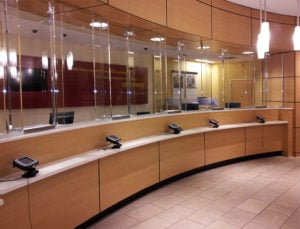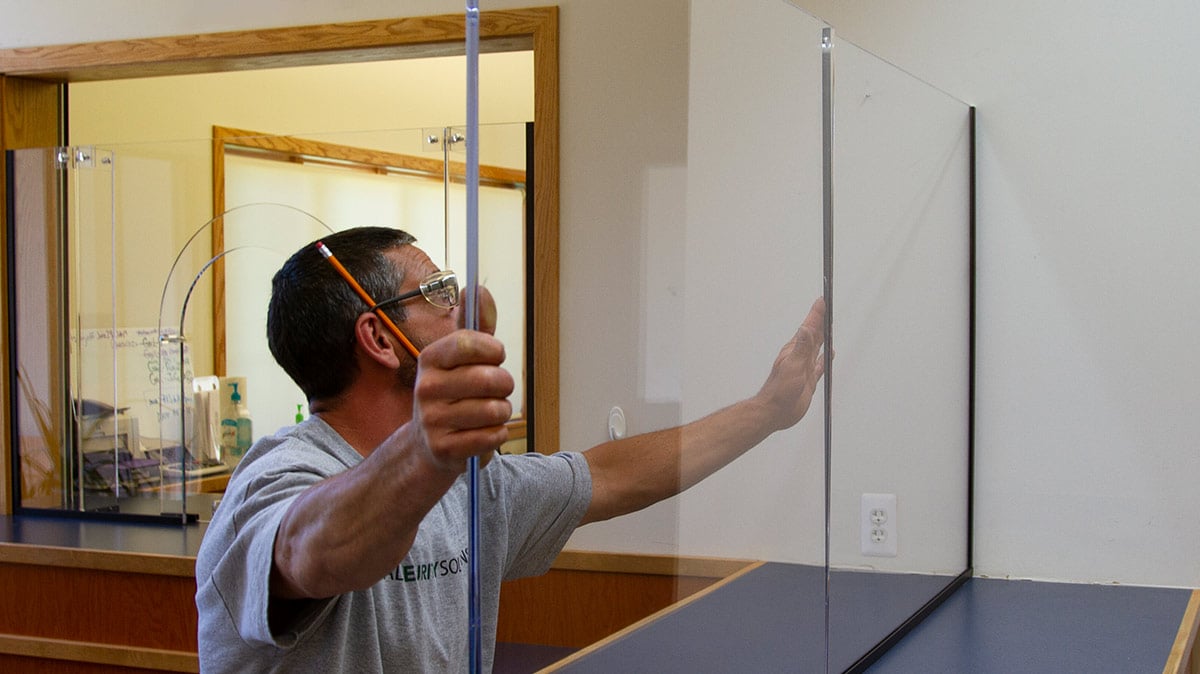An increasing number of physical security companies—and even traditional builders—are offering bullet-resistant components and security design. But it’s rare they handle their own bulletproof glass installation. Instead, they rely on an “installation network”—in other words, they subcontract the final installation to local glaziers and contractors. While these may be excellent contractors, they don’t necessarily have a ton of experience handling and installing bullet-resistant materials. Jim Richards, CEO of Total Security Solutions, has seen how inexperienced installations can turn out. Often, it just means an ugly installation: crooked window frames, rough-cut edges, exposed hardware, or misaligned sheets of bulletproof glass. But it can be worse. Jim recalls, “I’ve gone into banks and seen the system installed entirely backward”—that is, the baffles, like those shown below, placed on the customer side, instead of the interior.

Baffle windows on a “teller line” installation
This configuration isn’t just less safe (an armed assailant can angle their gun into the gap and create havoc in what should be the “secure area”). It also makes it harder to communicate through the windows (the baffle is designed to route sound around the window a certain way; mounting the panes incorrectly ruins this).
“Can someone else install our product?” Jim asks. “Without a doubt. Especially when it comes to single components, like a door or a transaction window.”
But inexperienced contractors don’t always lead to ugly installations. Jim Richards and Total Security Solutions have helped many contractors and glaziers through their first install.
Take a deeper dive into our Ultimate Guide to Bulletproof Glass & Bullet-Resistant Barriers
Guiding Novice Installers in Best-Practice Bulletproof Glass Installation
In contrast to most bulletproofing companies, TSS has always been an installer as well as a fabricator. In fact, when they got their start, they were exclusively self-installing. Owing to this background in installation, TSS is uniquely positioned to understand everything that goes into a smooth installation. More importantly, they have insights into what a supplier or manufacturer can do to make sure installation goes well and how to guide a team through it effectively.
For example, for several years, TSS worked with Marathon Petroleum, helping them secure corporate facilities. The nature of these ongoing renovations meant that Marathon needed just a few components installed at a time. It wasn’t feasible to bring in a TSS install team every six weeks. Instead, Jim and his team came down and trained Marathon’s internal carpenters in best-practices for bulletproof glass installation. After that, it was a simple matter of shipping them components and offering phone support as needed.
But not every job is a good fit for handing off. “When you’re starting to put systems in or integrate multiple trades, it’s more complicated, more of a puzzle. We know all the little tricks of the trade, how to clean things up, and make them look nice.”
Big Installs Should Never Be Big Headaches
TSS recently completed a large installation for a global technology company. This was a multi-crew, multi-day installation, converting five offices and six conference rooms into bullet-resistant safe-spaces with Level 5 security. (That means walls, windows, and doors designed to stop larger caliber assault rifles.) Just the bullet-resistant materials and components filled an entire semi-trailer truck.
It was a big job with a big price tag—but by no means the biggest TSS had tackled. What made this a challenge was that it was a fifth-floor office and the building had no freight elevator. There was only one way to get that truckload of material into that fifth-floor space: through a single window.
“They thought there was no way to get the material up into the building,” Jim explains. “They’d tried several local glaziers, but no one wanted any part of the job. Either they didn’t have the expertise, or they couldn’t handle the liability, or they just didn’t have the wherewithal to make it happen. And I can see why. In the end, we hired a rigger crane company, which handled all the local insurance and permitting issues to block off the streets. We coordinated with the riggers well in advance, to be sure that we crated all of the materials with the proper weight and size so that the crane could lift and maneuver to get them through the window.”
Was this job an amazing feat of engineering?
“No—in a lot of ways, it was no different than any other job. But it illustrates that sometimes you need to bring in someone who’s invested in that in-house expertise. You need the right team, who knows how to make big plans and get big things done right.”
Three Keys to Smooth Bulletproof Glass Installation
TSS currently employs the largest—and most sought after—bulletproof glass installation team in North America.
“Because we’re headquartered in Michigan, it can be hard for people to wrap their heads around this. We service installs on the East Coast, the West Coast, Texas, Oklahoma, the Pacific Northwest, along both the Canadian and Mexican borders—everywhere. And because we’ve had to make that work, we’ve really gotten the whole end-to-end process down. Not just designing, engineering, and fabricating a good system. We’ve also really streamlined the packaging and shipping, so that unpacking and assembly—whether it’s by our team, your team, or contractors you’ve hired locally—goes smoothly. Most years, 90% of what we do is a one-day install. In almost every situation an installation can be completed over a weekend.”
From TSS’s perspective, there are three keys to a smooth bulletproof system installation:
- Communicate
- Keep a schedule
- Get it right and leave it clean
Communication
“Whether it’s working directly with the end-user—the company who will use the system every day—or coordinating with a contractor who is installing our product, we keep communicating. Especially now, things can come up very quickly that might cause issues or disrupt business or travel. I don’t like anyone having any surprises.”
Keeping a Schedule
“Subcontractors are forever over-promising and missing dates and not showing up. That’s the industry, but that’s not us. When we say we’ll be ready, we’ll be ready. If we agree to have it done so you can open tomorrow at 8 am, it will be done.”
Get It Right, and Leave It Clean
“In construction, there’s an expectation you’re gonna have punch list items after a job is ‘done,’ things that you’ll have to come back around and fix or finish. We aim to never have a punch list. Part of that’s practical: If my team is from Michigan and they’re installing in Atlanta, the turnaround to get back to that job can take days. Our goal is to do that job right and thoroughly in one go. And when we leave your place, my expectation is that it’s spotless: The glass is clean, everything is vacuumed, everything is wiped down. And most importantly – it looks better than when we got there.”


